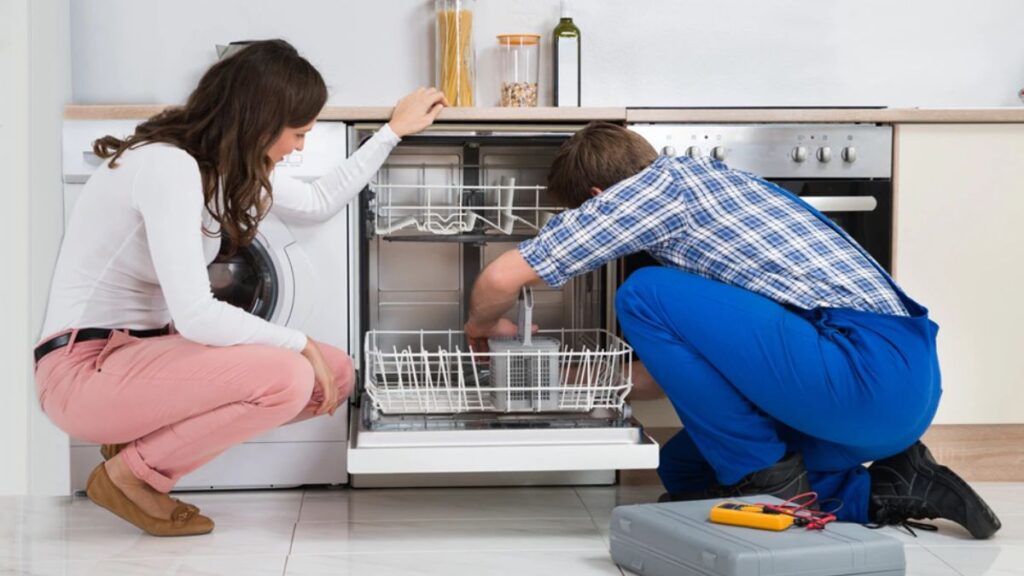Your washing machine just stopped working mid-cycle, leaving you with soggy clothes and a growing pile of laundry. Sound familiar? We’ve all been there, staring at a broken appliance and wondering whether to fix it or just buy a new one.
The answer isn’t always straightforward. Sometimes a simple repair can give your appliance years of extra life, while other times you might be throwing good money after bad. With the average American household spending over $2,000 annually on appliance purchases and repairs, making the right choice can significantly impact your budget.
The 50% Rule That Changes Everything
Here’s a guideline that repair experts swear by: if the cost of fixing your appliance is more than 50% of what a new one would cost, it’s usually time to replace it. But this rule has exceptions that can save or cost you hundreds.
A 3-year-old refrigerator that needs a $400 repair? That’s worth fixing when a comparable new unit costs $1,200. The same repair on a 12-year-old unit might not make financial sense, especially when you factor in efficiency improvements in newer models.
The trick is getting accurate estimates for both repair and replacement costs. Don’t forget to include delivery, installation, and disposal fees for new appliances – these can add $200-400 to your total cost.
[Get Professional Assessment: 704-606-9043]
Age Matters More Than You Think
Most major appliances have predictable lifespans, but these numbers tell only part of the story:
- Refrigerators: 10-15 years
- Washing machines: 8-12 years
- Dishwashers: 7-10 years
- Dryers: 10-15 years
- Ovens and ranges: 13-15 years
- Microwaves: 7-10 years
If your appliance is past the halfway point of its expected life and needs a major repair, replacement often makes more sense. Younger appliances, on the other hand, are usually worth fixing since they have plenty of good years left.
But age alone doesn’t tell the whole story. A well-maintained 8-year-old dishwasher might outlast a neglected 4-year-old unit. Usage patterns matter too – a washing machine in a household of six will age faster than one serving two people.
The Hidden Costs of Hanging On
Beyond the repair bill, older appliances can drain your wallet in other ways. . A refrigerator from 2010 uses about 40% more electricity than today’s models. Energy efficiency has improved dramatically over the past decade, roughly $100-150 extra per year on your electric bill – money that could go toward a new appliance payment.
Water usage has improved too. Modern washing machines use 25-30 gallons per load compared to 40+ gallons for older top-loaders. In areas with expensive water rates, this adds up quickly.
Frequent breakdowns are another red flag. If you’ve called for repair of home appliances more than twice in the past year, your appliance is probably on its last legs. Each service call costs money, and the inconvenience of repeated failures has its own value.
When Repair Makes Perfect Sense
Some situations make repair the obvious choice, regardless of age or cost percentages.
Minor issues with newer appliances. A clogged drain line or worn door seal on a 4-year-old dishwasher? Get it fixed. These problems are usually inexpensive to address and don’t indicate broader issues with the appliance’s core systems.
High-end appliances. Premium brands often justify repair costs better than budget models. A $3,000 refrigerator is worth a $600 repair in most cases, especially when replacement would cost significantly more than a basic model.
Availability and compatibility. If your built-in appliance has custom dimensions or your kitchen layout makes replacement complicated, repair might be your best bet. Cabinet modifications and electrical work can add thousands to replacement costs.
Sentimental or aesthetic value. Some appliances become part of your home’s character. That vintage-looking range might be worth fixing even when the numbers don’t add up perfectly.
The Refrigerator Exception
Refrigerators deserve special consideration because they’re essential and expensive to replace. Unlike other appliances, fridges work around the clock, making energy efficiency crucial. Even an older unit that’s running well might benefit from professional refrigerator repair services to optimize performance and extend its life.
Small issues like temperature fluctuations or strange noises often signal problems that can be fixed before they become expensive disasters. A failing compressor might give warning signs for months before complete failure. Catching these early can mean the difference between a $200 repair and total replacement.
Refrigerator repairs that usually make sense include:
- Thermostat replacement
- Door seal repairs
- Ice maker fixes
- Fan motor replacement
- Defrost system repairs
[Schedule Refrigerator Inspection: 704-606-9043]
These repairs typically cost $150-400 and can extend your refrigerator’s life by several years.
Red Flags That Signal Replacement Time
Certain warning signs indicate your appliance is beyond economical repair:
Multiple system failures. When your washing machine needs a new motor AND transmission, you’re looking at major expenses with no guarantee other components won’t fail soon.
Rust and corrosion. Visible rust, especially around water connections, often indicates problems that go deeper than what’s visible. Water damage can affect electrical components and create safety hazards.
Parts availability issues. If your repair technician has trouble finding parts, or if parts cost more than expected because they’re rare, replacement might be more practical.
Safety concerns. Gas appliances with cracked heat exchangers or electrical appliances with frequent circuit breaker trips need immediate attention. Sometimes replacement is the only safe option.
Making the Smart Choice
Start by getting a diagnosis from a qualified technician. Most reputable repair services charge a reasonable diagnostic fee that gets applied to any repair work. This small investment can save you from making a costly mistake.
Don’t accept phone quotes without an inspection. What sounds like a simple fix might reveal complicated underlying problems once the technician sees your specific situation.
Consider your household’s needs too. A family of five puts different demands on appliances than a couple without kids. Heavy usage might tip the scales toward replacement, even for a repairable appliance.
Think about timing as well. If your 10-year-old dryer breaks in December when sales are common, replacement might make more sense than the same repair would in March.
The Environmental Factor
Environmental impact adds another layer to the decision. Manufacturing new appliances requires significant energy and raw materials. Repairing an existing appliance almost always has a smaller environmental footprint than replacement.
However, the energy savings from newer appliances can offset manufacturing impact over time. An energy-efficient refrigerator might “pay back” its environmental cost within 3-5 years through reduced electricity usage.
Financial Strategies That Help
Several approaches can make either choice more affordable:
Extended warranties can change the repair math significantly, but read the fine print. Many warranties exclude common failure points or require expensive authorized service.
Credit card protection sometimes extends manufacturer warranties or provides purchase protection that can help with early failures.
Seasonal timing can save hundreds on replacement costs. Late fall and early spring typically offer the best appliance deals.
The Bottom Line
The replace-or-repair decision comes down to math, but not just the obvious kind. Factor in energy costs, reliability, convenience, and how much hassle you’re willing to tolerate. When in doubt, get a professional opinion before making expensive assumptions.
Your appliances work hard for your family. Sometimes they deserve a second chance, and sometimes they’ve earned their retirement. The key is knowing which situation you’re facing and having all the information needed to make a smart financial decision.
[Contact Our Experts Today: 704-606-9043]
Don’t let appliance problems disrupt your daily routine. Our experienced technicians can help you make the right choice for your home and budget, whether that means expert repair or guidance on replacement options.
Frequently Asked Questions
Q1. Should I repair or replace an appliance if the repair costs more than half the replacement price?
A1. If repair costs exceed 50% of the price of a new appliance and it’s past its halfway lifespan, experts generally recommend replacement .
Q2. How does an appliance’s age affect the repair vs. replace decision?
A2. Appliances approaching or beyond their expected life—e.g., refrigerators at 10–15 years, washers at 8–12 years—are often better replaced than repaired .
Q3. Can energy savings justify replacing an older appliance?
A3. Yes—older models can use 40% more energy than today’s ENERGY STAR units, so replacement can recoup costs via lower bills and reduced environmental impact .
Q4. What are signs that it’s time to replace rather than repair an appliance?
A4. Warning signs include frequent breakdowns, safety issues (like sparks or leaks), rust or corrosion, and difficulty sourcing parts—all strong indicators it’s time to replace .







